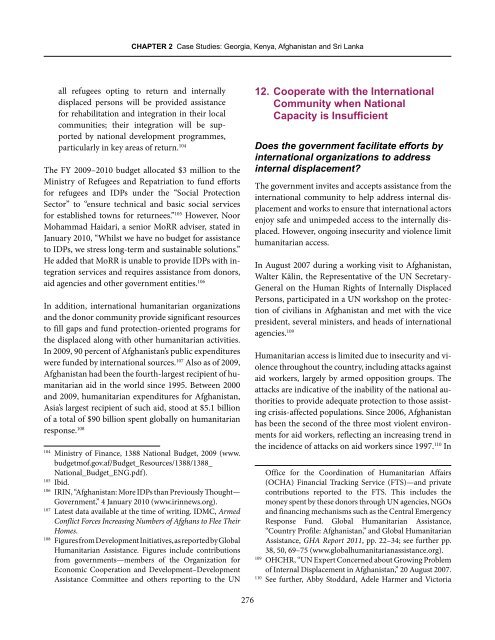From Responsibility to Response: Assessing National - Brookings
From Responsibility to Response: Assessing National - Brookings
From Responsibility to Response: Assessing National - Brookings
Create successful ePaper yourself
Turn your PDF publications into a flip-book with our unique Google optimized e-Paper software.
CHAPTER 2 Case Studies: Georgia, Kenya, Afghanistan and Sri Lanka<br />
all refugees opting <strong>to</strong> return and internally<br />
displaced persons will be provided assistance<br />
for rehabilitation and integration in their local<br />
communities; their integration will be supported<br />
by national development programmes,<br />
particularly in key areas of return. 104<br />
The FY 2009–2010 budget allocated $3 million <strong>to</strong> the<br />
Ministry of Refugees and Repatriation <strong>to</strong> fund efforts<br />
for refugees and IDPs under the “Social Protection<br />
Sec<strong>to</strong>r” <strong>to</strong> “ensure technical and basic social services<br />
for established <strong>to</strong>wns for returnees.” 105 However, Noor<br />
Mohammad Haidari, a senior MoRR adviser, stated in<br />
January 2010, “Whilst we have no budget for assistance<br />
<strong>to</strong> IDPs, we stress long-term and sustainable solutions.”<br />
He added that MoRR is unable <strong>to</strong> provide IDPs with integration<br />
services and requires assistance from donors,<br />
aid agencies and other government entities. 106<br />
In addition, international humanitarian organizations<br />
and the donor community provide significant resources<br />
<strong>to</strong> fill gaps and fund protection-oriented programs for<br />
the displaced along with other humanitarian activities.<br />
In 2009, 90 percent of Afghanistan’s public expenditures<br />
were funded by international sources. 107 Also as of 2009,<br />
Afghanistan had been the fourth-largest recipient of humanitarian<br />
aid in the world since 1995. Between 2000<br />
and 2009, humanitarian expenditures for Afghanistan,<br />
Asia’s largest recipient of such aid, s<strong>to</strong>od at $5.1 billion<br />
of a <strong>to</strong>tal of $90 billion spent globally on humanitarian<br />
response. 108<br />
104 Ministry of Finance, 1388 <strong>National</strong> Budget, 2009 (www.<br />
budgetmof.gov.af/Budget_Resources/1388/1388_<br />
<strong>National</strong>_Budget_ENG.pdf).<br />
105 Ibid.<br />
106 IRIN, “Afghanistan: More IDPs than Previously Thought—<br />
Government,” 4 January 2010 (www.irinnews.org).<br />
107 Latest data available at the time of writing. IDMC, Armed<br />
Conflict Forces Increasing Numbers of Afghans <strong>to</strong> Flee Their<br />
Homes.<br />
108 Figures from Development Initiatives, as reported by Global<br />
Humanitarian Assistance. Figures include contributions<br />
from governments—members of the Organization for<br />
Economic Cooperation and Development–Development<br />
Assistance Committee and others reporting <strong>to</strong> the UN<br />
276<br />
12. Cooperate with the International<br />
Community when <strong>National</strong><br />
Capacity is Insufficient<br />
Does the government facilitate efforts by<br />
international organizations <strong>to</strong> address<br />
internal displacement?<br />
The government invites and accepts assistance from the<br />
international community <strong>to</strong> help address internal displacement<br />
and works <strong>to</strong> ensure that international ac<strong>to</strong>rs<br />
enjoy safe and unimpeded access <strong>to</strong> the internally displaced.<br />
However, ongoing insecurity and violence limit<br />
humanitarian access.<br />
In August 2007 during a working visit <strong>to</strong> Afghanistan,<br />
Walter Kälin, the Representative of the UN Secretary-<br />
General on the Human Rights of Internally Displaced<br />
Persons, participated in a UN workshop on the protection<br />
of civilians in Afghanistan and met with the vice<br />
president, several ministers, and heads of international<br />
agencies. 109<br />
Humanitarian access is limited due <strong>to</strong> insecurity and violence<br />
throughout the country, including attacks against<br />
aid workers, largely by armed opposition groups. The<br />
attacks are indicative of the inability of the national authorities<br />
<strong>to</strong> provide adequate protection <strong>to</strong> those assisting<br />
crisis-affected populations. Since 2006, Afghanistan<br />
has been the second of the three most violent environments<br />
for aid workers, reflecting an increasing trend in<br />
the incidence of attacks on aid workers since 1997. 110 In<br />
Office for the Coordination of Humanitarian Affairs<br />
(OCHA) Financial Tracking Service (FTS)—and private<br />
contributions reported <strong>to</strong> the FTS. This includes the<br />
money spent by these donors through UN agencies, NGOs<br />
and financing mechanisms such as the Central Emergency<br />
<strong>Response</strong> Fund. Global Humanitarian Assistance,<br />
“Country Profile: Afghanistan,” and Global Humanitarian<br />
Assistance, GHA Report 2011, pp. 22–34; see further pp.<br />
38, 50, 69–75 (www.globalhumanitarianassistance.org).<br />
109 OHCHR, “UN Expert Concerned about Growing Problem<br />
of Internal Displacement in Afghanistan,” 20 August 2007.<br />
110 See further, Abby S<strong>to</strong>ddard, Adele Harmer and Vic<strong>to</strong>ria

















